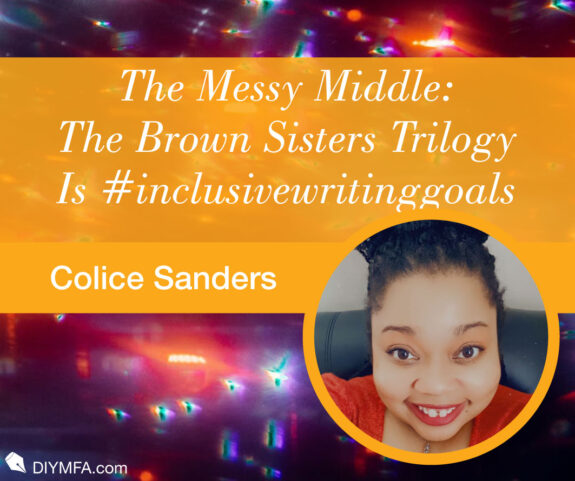Welcome back to The Messy Middle, where we focus on crafting complex characters and building dynamic worlds that connect with readers from marginalized communities.
In a previous post, The Messy Middle: Luna & The Rise of Trans Narratives, we examined the pitfalls of the young adult (YA) novel Luna, which provided a compelling “case study” for understanding the potential negative impact of misrepresenting trans communities in fiction.
The Brown Sisters Trilogy
I’m super excited to offer an additional “case study” of inclusive writing from The Brown Sisters trilogy, written by best-selling self-published author Talia Hilbert. This romance series offers an excellent example of what readers can gain from holistic writing that holds space for inclusion and representation, without sacrificing the complexities of the heart, humor, and humanity that are the foundation of the romance genre.
The Brown Sisters trilogy adheres to the common principles of the genre by chronicling the optimistic and aspirational enemies to lovers journey of clever and stubborn female protagonists. What makes it stand out are the steamy sex scenes, witty and humorous dialogue, and clever meta-commentary on the romance genre. Hilbert’s contemporary take on romance, sexuality, and interracial dating feels like a breath of fresh air.
The books in the series include Get A Life, Chole Brown (2019), Take A Hint, Dani Brown (2020), and Act Your Age, Eve Brown (2021). Each novel has received positive reviews and enjoyed great commercial success, which is even more impressive when considering the ways that the publishing industry has excluded authors of color from the genre.
A “Whites Only” Genre?
Full disclosure, before reading this series, I would not have identified as a romance genre reader. It wasn’t until I began doing research for this post that I realized that this was less about my actual preference and more about the effectiveness of the systematic racism constructed to exclude authors and readers of color from the romance genre.
In the mind-blowing article, “Fifty Shades of White: The Long Fight Against Racism in Romance Novels,” author Lois Beckett details how Harlequin and other publishing entities, have historically chosen to exclusively publish, promote, and award white romance authors, effectively limiting the genre to the experiences of able-bodied, white, Christian, middle class, and heterosexual women.
Apparently, I had subconsciously been influenced by this message because it wasn’t until I happened upon the first novel, Get A Life Chole Brown, one day in a Barnes & Noble, that I started to consider the genre.
#Representation Matters
The cover of the book featured a curvy black woman, which got my attention immediately.
What really convinced me to buy the book was the summary of the novel, which mentioned that the character had fibromyalgia. I was at the beginning of my Fibro diagnosis, and it felt like the universe had gifted me the opportunity to escape into another world where a curvy black woman with fibromyalgia finds her purpose.
Representation got me through the door with the first book. However, what led me to become a faithful reader and fan of Hilbert was her ability to effectively illustrate intersectionality. She expertly connects her inciting incidents to universal truths and enters through the side of marginalized identities of which she does not have direct experiences.
Show Us the Complexity of Humanity with Intersectionality
According to her website, taliahilbert.com, Hilbert writes “spicy diverse British romance because she believes that people of marginalized identities need honest and positive representation.” Hilbert provides that representation by masterfully illustrating the intricate humanity of intersecting and marginalized identities within the series.
The trilogy provides a breadth of perspectives that are often underrepresented in mainstream romance, such as neurodivergence (ADHD and autism), body image, sexuality, immigrant experiences, interracial relationships, trauma, racism, sexism, chronic illness, religious intolerance, and mental health (anxiety, depression, and PTSD) just to name a few. These portrayals are masterfully woven into the plotline in a way that highlights the challenges and resiliency of each identity.
Anchor Those Inciting Incidents to Universal Truths
An inciting incident is an important storytelling element utilized in all writing genres. Most stories are crafted to build up to a specific incident or its aftermath; the impact of that incident. It is very important that characters are developed beyond their marginalized identity and that their identity is not used as the inciting incident for the story.
Hilbert is an expert at pairing the complexities of marginalized identity with universal themes of human experience. I would argue that the series is essentially about the ways we hide out from life until we are ready to heal from past pain because all of the characters in the series must work to address universal themes of grief, loss, hitting rock bottom, and finding one’s purpose. These universal themes not only make the characters feel real but also offer the reader a perspective for overcoming or addressing their own struggles, which is a rare occurrence within the genre.
You’ve Got This!!!
Hopefully, reflecting on the positive representation of marginalized identity within The Brown Sisters trilogy has affirmed that it is possible to provide equitable and nuanced portrayals of marginalized communities when we are intentional with character development, world building, and plot. The Brown Sister series is an excellent reference point for understanding how to craft stories that hold space for inclusion and representation, without sacrificing the complexities of the heart, humor, and humanity.

Colice Sanders is a blogger and diversity, equity, and inclusion facilitator. Colice writes nonfiction, poetry, and memoir. Her blog, A Reason to Rise, chronicles her journey of radical self-acceptance through the lens of childhood trauma.







